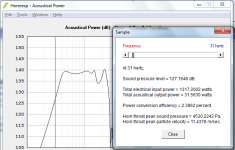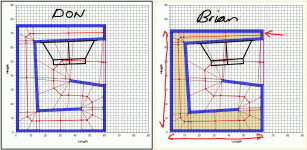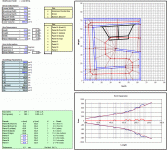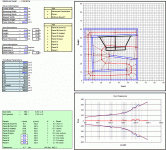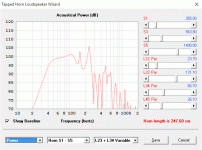Really close now. Some of the driver parameters differ, I will double check tom.
Since this is my thread, can I ask a (another) dumb question? Can anything be done to change the slope of low knee/F3? IE anyway to manipulate this design to get above 90db at 30Hz? No need to model or change anything, mostly just curious. From the HR wizard lengthening L34 helps. Not sure if that basically screws the entire design up or not.
Bedtime for zwiller
Fb for this alignment is just above 40 Hz. I wouldn't be concerned with anything below that, as it's likely to be accompanied by more distortion too.
If you really want to get more output @30 Hz, you'll need to reduce Fb without losing efficiency, which means making the box larger, and perhaps quite a bit larger, than it is right now.
Thanks. Downloaded the spec sheet and we're really REALLY close now. I was shortcutting using Part Express website data... no longer! I will tell you this. I am a bit shocked how much better the sim looks with the cone volume added.
In case anyone is looking at the PA380 version to save dough, the PA385 is easily 6db+ over it. It's a no brainer...
This is now simming much like Don's and a 4 pack is loud, flat, and digs quite low. 127db @ 31Hz BTW 😎 If you get the drivers on sale and eek out 4 cabs from 5 sheets of ply, you are talking 140db to 40Hz for well under 1k, more like $800 and alot easier to move for one dude...
Although I am more than happy where we stand and plan to build one, I would be curious if we could get creative later on and get F3 lower via cone correction/longer path with S1. I still think there's some magic there.
In case anyone is looking at the PA380 version to save dough, the PA385 is easily 6db+ over it. It's a no brainer...
This is now simming much like Don's and a 4 pack is loud, flat, and digs quite low. 127db @ 31Hz BTW 😎 If you get the drivers on sale and eek out 4 cabs from 5 sheets of ply, you are talking 140db to 40Hz for well under 1k, more like $800 and alot easier to move for one dude...
Although I am more than happy where we stand and plan to build one, I would be curious if we could get creative later on and get F3 lower via cone correction/longer path with S1. I still think there's some magic there.
Attachments
I am a rookie but it looks like you might have a winner of an idea here Zwiller. The price of those drivers on sale is hard to beat. I will definitely be following this thread.
Do you recall the price for the PA385 was it when on sale? I have been spoiled since I snagged the LAB15-4 for $125 shipped.
Right around $150 USD last month I believe. I almost bought one to mess with in a Tham but didn't want to start making dust and just pop a driver in a cab it wasn't designed for.
Last edited:
Right around $150 USD last month I believe.
SHAZBOT! Started this thread 8/13. 🙄 At least the design is coming together...
They will be on sale again, I will try to remember to post here the next time I see them on sale. I have a couple coupon codes ready to take some more off of the price.
Here is a sim using B&C 15NW76 and Brian's parameters.
This should shave 15lbs off the box. The sensitivity is higher than the Dayton but the power handling is less. I don't know how that would affect the max output of the box with the dayton vs the b&c.
I would guess that the performance would be about the same as a ss15 since the box is same size and the power handling and sensitivity are close to the 3015LF. I'm just guessing though.
An externally hosted image should be here but it was not working when we last tested it.
This should shave 15lbs off the box. The sensitivity is higher than the Dayton but the power handling is less. I don't know how that would affect the max output of the box with the dayton vs the b&c.
I would guess that the performance would be about the same as a ss15 since the box is same size and the power handling and sensitivity are close to the 3015LF. I'm just guessing though.
Thanks. I might grab a PA380 and make sawdust sooner than later. Wish I could be more helpful and do CAD stuff for us. I will at least attempt an old school/paper cutlist. I am curious how close to a single sheet we can get...
and the b&c 15nbx100
The power handling is the same as the Dayton but has a higher sensitivity and 15lbs lighter. This looks like it would be a little monster to my untrained eye. I'm not sure if the extra $$$ is worth the 15 lbs weight difference though. I might just hit the gym a little harder.
An externally hosted image should be here but it was not working when we last tested it.
The power handling is the same as the Dayton but has a higher sensitivity and 15lbs lighter. This looks like it would be a little monster to my untrained eye. I'm not sure if the extra $$$ is worth the 15 lbs weight difference though. I might just hit the gym a little harder.
Last edited:
571,5 x 609,6 x 762 (mm) = 265,2dm3 (THAM15DS)
500 x 550 x 680 (mm) = 187dm3 (THAM15)
I admire Don's take on the THAM15 design, and I'm sure it will perform admirably, but it is more then a slight change of external dimensions, it is in fact a design some 42% larger and it should thereby logically be a design reaching deeper as well as being more sensitive and with a higher max SPL average compared to the original when loaded with an equal driver, or even a less costly one.
500 x 550 x 680 (mm) = 187dm3 (THAM15)
I admire Don's take on the THAM15 design, and I'm sure it will perform admirably, but it is more then a slight change of external dimensions, it is in fact a design some 42% larger and it should thereby logically be a design reaching deeper as well as being more sensitive and with a higher max SPL average compared to the original when loaded with an equal driver, or even a less costly one.
The 15TBW100 will give you another 1.5-2db output if you can feed it 1kw. Personally, I don't think it's worth the extra $$ for neo (I work out 😀) BUT from hanging around here, the B&Cs supposedly can take the punishment/do well beyond xmax. They can be reconed but not Dayton. Like all things, it's a choice. I would probably just buy spare PA385s.
RE SS15 vs this design. I have several iterations of the SS15 in HR and not sure what the "official" one is but I think this new design goes a bit lower and that is needed in modern music and not just EDM. TKO, if you are talking modern country (almost rock), I imagine you need the extension. I think there are some 5 and 6 string bass in modern country as well as synth but seep the tunes and check.
I had no idea Don's design was that much larger compared to the original THAM15... Wow. I would have used the original design but couldn't find drivers that simmed well.
RE SS15 vs this design. I have several iterations of the SS15 in HR and not sure what the "official" one is but I think this new design goes a bit lower and that is needed in modern music and not just EDM. TKO, if you are talking modern country (almost rock), I imagine you need the extension. I think there are some 5 and 6 string bass in modern country as well as synth but seep the tunes and check.
I had no idea Don's design was that much larger compared to the original THAM15... Wow. I would have used the original design but couldn't find drivers that simmed well.
The 15TBW100 will give you another 1.5-2db output if you can feed it 1kw. Personally, I don't think it's worth the extra $$ for neo (I work out 😀) BUT from hanging around here, the B&Cs supposedly can take the punishment/do well beyond xmax. They can be reconed but not Dayton. Like all things, it's a choice. I would probably just buy spare PA385s.
RE SS15 vs this design. I have several iterations of the SS15 in HR and not sure what the "official" one is but I think this new design goes a bit lower and that is needed in modern music and not just EDM. TKO, if you are talking modern country (almost rock), I imagine you need the extension. I think there are some 5 and 6 string bass in modern country as well as synth but seep the tunes and check.
I had no idea Don's design was that much larger compared to the original THAM15... Wow. I would have used the original design but couldn't find drivers that simmed well.
As far as the tracks I am going to play along with, I am looking through a few in a spectrum analyzer and yes, there is a lot of content down below 50hz, especially on the songs people dance to.
I am rethinking the weight deal after seeing this. A few extra pounds isn't going to kill me. The extra price of a neo B&C kind of ruins the fun of good performance out of the dirt cheap Dayton driver. Hopefully this will mature and the Dayton prove to be durable.
Just a few things:
1. There are two "THAM2" designs discussed in this thread - Don's original design, and my tweaked designs. My design has a higher CR (about 3:1 at S2) than Don's and the size is slightly smaller (it's shorter, and slightly wider). See illustration below. Don's version might be more suitable for drivers with lower motor strength.
2. AFAIK, none of these designs are tested.
3. I've assumed 5000 cm^3 of cone volume in my analysis. The actual volume needs to be calculated or measured. HornResp provides a tool to do this. The sim should then be adjusted accordingly. While it's Ok to under-estimate Vtc, over-estimating it will lead to a higher CR than expected and lower output in the passband, and you probably don't want that to happen in a PA bass bin build.
4. I've used the PA380. Given this design, I'd most likely opt to go with the PA385, or another driver with a sturdier cone instead. The PA380's cone is fairly soft, and it seems more suited for 2-way or 3-way tops rather than subwoofer duty (says the guy who deployed them for the latter purpose, LOL). JBL/Infinity folds over the edges of the cones for their car audio subwoofer drivers, which stiffens them up considerably - it's strange that this feature hasn't shown up in high-power PA subwoofer drivers yet, as it's a simple but very effective solution.
5. 17mm ply is assumed for the build. If you use something different, the design will have to be adjusted. And that's the beauty of having this design described by a spreadsheet - it makes those adjustments a lot easier 🙂
6. The mouth is fairly large wrt the driver, which is a good thing. As the mouth size decreases, the impact of the driver's volume is greater, and could account for the drooping response at the upper end of the passband in the measurements of the original THAM, which has a smaller mouth.
1. There are two "THAM2" designs discussed in this thread - Don's original design, and my tweaked designs. My design has a higher CR (about 3:1 at S2) than Don's and the size is slightly smaller (it's shorter, and slightly wider). See illustration below. Don's version might be more suitable for drivers with lower motor strength.
2. AFAIK, none of these designs are tested.
3. I've assumed 5000 cm^3 of cone volume in my analysis. The actual volume needs to be calculated or measured. HornResp provides a tool to do this. The sim should then be adjusted accordingly. While it's Ok to under-estimate Vtc, over-estimating it will lead to a higher CR than expected and lower output in the passband, and you probably don't want that to happen in a PA bass bin build.
4. I've used the PA380. Given this design, I'd most likely opt to go with the PA385, or another driver with a sturdier cone instead. The PA380's cone is fairly soft, and it seems more suited for 2-way or 3-way tops rather than subwoofer duty (says the guy who deployed them for the latter purpose, LOL). JBL/Infinity folds over the edges of the cones for their car audio subwoofer drivers, which stiffens them up considerably - it's strange that this feature hasn't shown up in high-power PA subwoofer drivers yet, as it's a simple but very effective solution.
5. 17mm ply is assumed for the build. If you use something different, the design will have to be adjusted. And that's the beauty of having this design described by a spreadsheet - it makes those adjustments a lot easier 🙂
6. The mouth is fairly large wrt the driver, which is a good thing. As the mouth size decreases, the impact of the driver's volume is greater, and could account for the drooping response at the upper end of the passband in the measurements of the original THAM, which has a smaller mouth.
Attachments
Sorry for a small tangent here...As I said earlier, I am still deciding on a design for a 4 sub build for a two person live act that will use guitar, 4 string bass and a synth/drum accompaniment track. I am trying to decide if the SS15 will work for what I will be playing. Below is a selection of 4 songs that are a good mix of what we will be playing. I am trying to decide is the ss15 will dig low enough to give a good dance thump with these tracks or if it would be worth the cost and weight to experiment with something like the design on this thread or one of the larger THs here. I would like to get by with using just 2 of the boxes for smaller indoor shows.
Thanks again for the help.
song1
song 2
song 3
song 4
Thanks again for the help.
song1
An externally hosted image should be here but it was not working when we last tested it.
song 2
An externally hosted image should be here but it was not working when we last tested it.
song 3
An externally hosted image should be here but it was not working when we last tested it.
song 4
An externally hosted image should be here but it was not working when we last tested it.
Last edited:
Ok, here's a minor update that keeps the top and bottom panels the same width as the internal panels. This makes cutting them out a lot easier.
BTW - what's everyone's favourite cut-sheet program? I think it would be interesting to see how close this design is to a single-sheet one.
BTW - what's everyone's favourite cut-sheet program? I think it would be interesting to see how close this design is to a single-sheet one.
Attachments
Sorry for a small tangent here...As I said earlier, I am still deciding on a design for a 4 sub build for a two person live act that will use guitar, 4 string bass and a synth/drum accompaniment track. I am trying to decide if the SS15 will work for what I will be playing.
At least four of those tracks have noticeable content below 40 Hz.
However, this might be noticeable in a graph, but not really in actual listening.
If I was you and I was thinking ONLY of that purpose for the sub, I'd probably rent a sub or two and use an EQ to match its LF response as close as you can get to the SS15 (basically introduce a sharp cut below 50 Hz). If it sounds fine to the band, then the LF performance of the SS15 should be fine as well.
However, if I was thinking of making them a bit more general purpose in nature, I'd likely go with subs with a bit more LF capability at 40 Hz than what the SS15s can deliver.
571,5 x 609,6 x 762 (mm) = 265,2dm3 (THAM15DS)
500 x 550 x 680 (mm) = 187dm3 (THAM15)
I admire Don's take on the THAM15 design, and I'm sure it will perform admirably, but it is more then a slight change of external dimensions, it is in fact a design some 42% larger and it should thereby logically be a design reaching deeper as well as being more sensitive and with a higher max SPL average compared to the original when loaded with an equal driver, or even a less costly one.
Hmm...
I'm wondering how much Don's design can be "squeezed down" to approach the 187L volume of the THAM15?
Here's something I came up with that's partway there. Box volume works out to 208L. The response is sloping upwards, but I'll bet that the measured response will show less of a slope, if any at all, because now the driver's size is likely going to start to have an impact. This design also has an Fb of around 42 Hz, so a mild boost can be applied at or slightly above there to flatten the passband. Box dimensions work out to 24" x 24" x 22", which is pretty small...
I'm going to try to see if I can get it down to 190 L tomorrow, without sacrificing too much of the response.
Attachments
Thanks Brian, I would like to keep my setup two way so this design is looking good to me. I would rather have a handful of something this size in my garage vs a couple of the 18" designs on here so I would have some flexibility when I can get by with just two boxes.
I would would be willing to build a prototype out of braced ACX plywood and testing the next time the drivers go on sale. I have made a few BFM designs in the past with good results. I have a couple friends who are experienced hifi builders who would could help get accurate measurements and make sure I'm doing it right.
I would would be willing to build a prototype out of braced ACX plywood and testing the next time the drivers go on sale. I have made a few BFM designs in the past with good results. I have a couple friends who are experienced hifi builders who would could help get accurate measurements and make sure I'm doing it right.
Last edited:
Brian, thank you again. Specifically the same width panel change. I think this makes construction a bit more forgiving too.
I've simmed the heck out of the THAM15 and SS15 and I think they are basically about the same, 50hz boxes. I don't think the increase in size with the current design has radically affected portability and would urge us to stick with it. As I said, I would like to fool around with some 3d folding near S1 stuff and try and coax out 100db at 40Hz or bring up 30Hz a few db with experimentation. We might have to use Don's design to approach this as CR on your design is running on the high side.
Not sure how accurate we can get wrt to cone volume without actually measuring with driver in hand (or contacting Dayton) but I tried several times and get something more along the lines of 7000cm3.
KTO, while this design is not "proven" per se, the concept (THAM) sure is but I like Brian's idea to rent and i would do that until the design is tested or just go ahead build a pair of SS15. It is very easy to OCD about LF... Something I read here is pretty much my take on this: if you don't hear it, you won't know it's missing, but once your hear it, you'll want to have it. Something like that.
I've simmed the heck out of the THAM15 and SS15 and I think they are basically about the same, 50hz boxes. I don't think the increase in size with the current design has radically affected portability and would urge us to stick with it. As I said, I would like to fool around with some 3d folding near S1 stuff and try and coax out 100db at 40Hz or bring up 30Hz a few db with experimentation. We might have to use Don's design to approach this as CR on your design is running on the high side.
Not sure how accurate we can get wrt to cone volume without actually measuring with driver in hand (or contacting Dayton) but I tried several times and get something more along the lines of 7000cm3.
KTO, while this design is not "proven" per se, the concept (THAM) sure is but I like Brian's idea to rent and i would do that until the design is tested or just go ahead build a pair of SS15. It is very easy to OCD about LF... Something I read here is pretty much my take on this: if you don't hear it, you won't know it's missing, but once your hear it, you'll want to have it. Something like that.
- Status
- Not open for further replies.
- Home
- Loudspeakers
- Subwoofers
- Help reverse engineering sim THAM15DS
